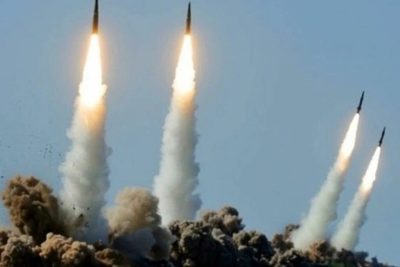Washington based Think Tank: Russia Unlikely to Ever Run Out of Missiles

All Global Research articles can be read in 51 languages by activating the Translate Website button below the author’s name.
To receive Global Research’s Daily Newsletter (selected articles), click here.
Click the share button above to email/forward this article to your friends and colleagues. Follow us on Instagram and Twitter and subscribe to our Telegram Channel. Feel free to repost and share widely Global Research articles.
***
For approximately a year and a half, we have been listening to tall tales about Russia running out of munitions of various kinds due to its supposed “inability” to produce advanced weapons, particularly long-range missiles and other sorts of PGMs (precision-guided munitions). According to mainstream propaganda, Moscow is allegedly “so desperate” that it had to “arm” its soldiers with shovels and resort to the expropriation of washing machines, smartphones, laptops and other devices that contain microchips in order to maintain production. Such ludicrous claims would never be accepted by anyone remotely familiar with how advanced military technologies work.
However, they are an important segment of the rabidly Russophobic infowar that aims to present the Eurasian giant as supposedly “technologically backward”. And yet, after Moscow’s long-range and tactical aviation, as well as naval and ground-based units, spent the entire special military operation (SMO) launching high-precision strikes by using advanced PGMs that quite literally nobody else has (the United States included), the mainstream propaganda machine simply had to admit something was seriously off with their assessment of Russia’s technological and industrial capacity. The latter should have been destroyed by Western sanctions close to a year and a half ago.
And yet, it’s still standing. The answer as to why this is the case was recently given by CSIS (Center for Strategic and International Studies), a Washington DC-based think tank that is among the most prominent ones in the US. According to their assessment, Moscow is extremely unlikely to run out of PGMs and other long-range high-precision weapons, either for itself or its numerous export customers. Somewhat surprisingly, with no ambiguity or sugarcoating, Ian Williams, a Fellow of the International Security Program and Deputy Director of the Missile Defense Project at CSIS, has made it perfectly clear that it would be “unrealistic to expect Russia to ever run out of missiles”.
The author further notes that Moscow will be able to continue building long-range PGMs, which will enable it to sustain constant long-range strike capability, “despite sanctions and export restrictions”. And while the CSIS report parroted the usual propaganda narratives about Russia, such as that its military supposedly “regularly attacked a range of military and civilian targets throughout Ukraine with costly, long-range missiles”, its findings should certainly not be dismissed. It admitted that numerous weapons experts found conclusive evidence of recently manufactured Russian cruise missiles and other PGMs that have been used in the SMO.
Still, once again, the US think tank obviously didn’t want to let another opportunity to fight the infowar go to waste, so it claims that this supposedly “indicates that Russia’s arsenal has become so depleted that weapons are being used in the conflict just a few months after manufacturing”. And while most US and other Western high-ranking officials insisted that “rebuilding the Russian stockpile will be a lot harder” due to sanctions, particularly when it comes to acquiring microchips, the latest CSIS report disproves such claims, with the author complaining that export restrictions didn’t have the desired effect on Russian missile production.
“There is no one-off fix for this problem. At most, sanctions and export controls can limit the quantity and quality of strike assets Russia can acquire,” the report admits while simultaneously parroting the regular propaganda narrative. The author then continues with the mental gymnastics by trying to “rationalize” the said propaganda narrative in line with the actual situation on the battlefield, claiming that “it’s likely Russia swiftly used up the portion of the long-range missiles that it had originally designated for the SMO”. However, he admits that “despite this, Russia continued to launch missiles against Ukraine, perhaps by withdrawing munitions from other theaters of operation”, without specifying which ones.
The report concedes that Russia continued to produce missiles during the SMO and that the evidence suggests that the majority (or maybe even all) of cruise missiles in its current arsenal were made after the SMO started. Still, the author once again insists that the supposed “depletion” of pre-SMO stocks “has altered the composition of modern Russian strike salvos” and that “Russian missile attacks have shifted from high-end missile systems like cruise missiles towards less effective, less expensive low-end systems like ‘Shahed-136/Geranium 2’ kamikaze drones”.
However, the author fails to accept the fact that these systems are simply much more cost-effective, which is why they’re being used in the first place. The report admits that despite export restrictions, particularly on crucial microelectronic components, Russia has continued manufacturing advanced long-range missiles and PGMs. Still, the author insists this is because Russia is supposedly “acquiring these Western-produced components via friendly third parties”. According to the report, the result is that “Russia will continue having the capacity to build missiles and drones and will continue to use them” and that “this reality will not change until the war ends”.
*
Note to readers: Please click the share button above. Follow us on Instagram and Twitter and subscribe to our Telegram Channel. Feel free to repost and share widely Global Research articles.
Drago Bosnic is an independent geopolitical and military analyst.
Featured image is from InfoBrics

